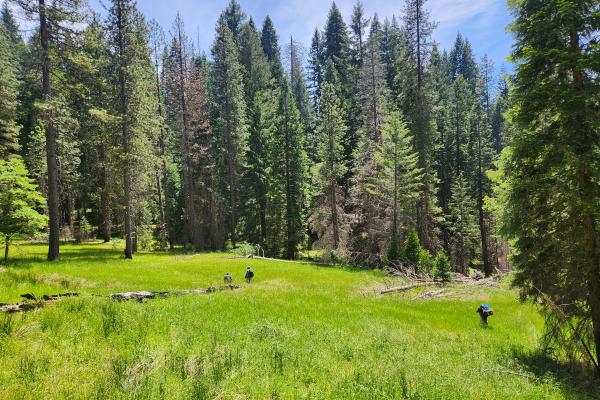Taking the Pulse: Measuring Restoration Success
April 29 - May 2, 2025
The Role of Meadows in Water-Fire-Fish Processes Across the Landscape
02 May 2025
1:30pm - 5:00pm
Session Coordinator: Emily Cooper-Hertel, Klamath Meadows Partnership and Jay Stallman, Senior Geomorphologist, Stillwater Sciences
Despite their relatively small coverage of area across the landscape, meadows have a landscape scale impact when they are able to retain and slowly release water to lower watershed areas during the dry season. Many wet meadows in the Klamath, North Coast, and Sierra Mountain Ranges are important not only for their connection to fish habitat downstream, providing cold water refugia required by summer rearing salmonid species, but also for their wildfire refugia capabilities throughout upland areas. This session explores the role of meadows in holistic watershed stewardship, from wildfire resilience in forests to water security in streams. Meadows can act as a geomorphic hydraulic control at the watershed scale; however, altered hydrologic and fire disturbance regimes have impaired the ability of meadows to hold water that supports specific plant and animal communities locally as well as those farther downstream with seasonal water release.
This session is intended to explore the effects on eco-hydrologic processes at the watershed scale in response to fuels, fire, and instream restoration locally within and around meadows. A better understanding of meadow distribution, condition, and restoration across the landscape can help inform the role and need for meadows as integral components of watershed processes. We would like to explore knowledge of the dynamics between groundwater and surface water from geologic, geomorphologic, vegetation, and climatic conditions. How does upland fire and fuels management pair with meadow restoration regarding surface and groundwater availability? Can targeting upland forest restoration where there are high densities of meadows maximize potential increases and durations in water yields due to the natural water storage characteristics of meadows in the watershed? Do dry meadows and grasslands treated with beneficial burning improve forest and stream health? Do healthy meadows improve seasonal fish habitat? What meadow restoration strategies have worked or are desired with integrated forest and instream management? How can traditional ecological knowledge of watershed stewardship highlight the role of meadows in forest and stream health?
This session invites the knowledge, practice, and science behind meadows as they relate to fire, water, and fisheries management and landscape restoration strategies. We also propose to allocate one presenter time slot to a Q/A and discussion between presenters and the audience in the interest of a more interactive experience for all.
Understanding and Restoring Meadows of Northern California through Meaningful Collaboration, Emily Cooper-Hertel, Klamath Meadows Partnership Coordinator, Watershed Research and Training Center
Fish & Fire: Insights from Three Years of Workshops and Dialogue, Lenya Quinn-Davidson, Fire Network Director, University of California Agriculture and Natural Resources and Josh Smith, Watershed Stewardship Program Director, Watershed Research and Training Center
“How Do We Get There?” Building a Meadow Restoration Program, Megan Ireson, Mountain Meadows Project Coordinator, Scott River Watershed Council
Integrating Forest Health with Meadow Restoration in the Middle Truckee River Basin, Brian Hastings, P.G., Senior Geomorphologist, Balance Hydrologics; and Beth Christman, PhD, Senior Director of Restoration, Truckee River Watershed Council
Low-Tech Process-Based Riparian Meadow Restoration in Post-Wildfire Landscapes Rapidly Captures Sediment and Reconnects Floodplains, Karen Pope, PhD, Research Aquatic Ecologist, USDA Forest Service, Pacific Southwest Research Station
Restoring Meadows and Flows for Eagle Lake Rainbow Trout, Kate Gazzo, Director, Northern Sierra Headwaters Conservation, American Rivers; and Michael Cameron, Northern Sierra Project Manager, Trout Unlimited
Panel Discussion and Interactive Q&A

